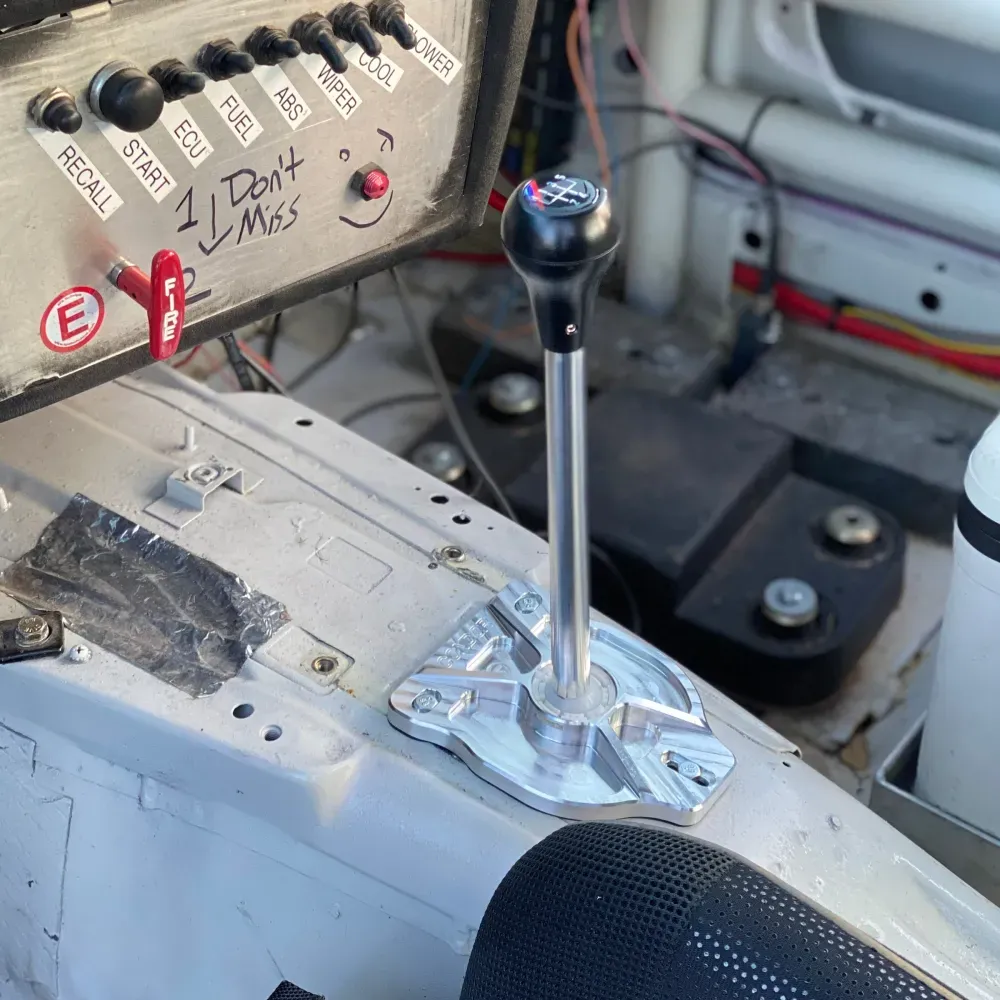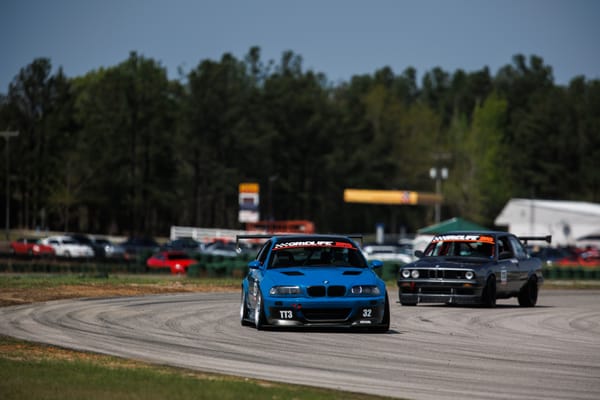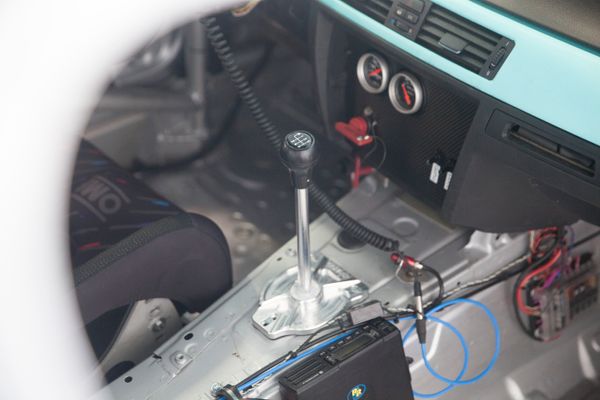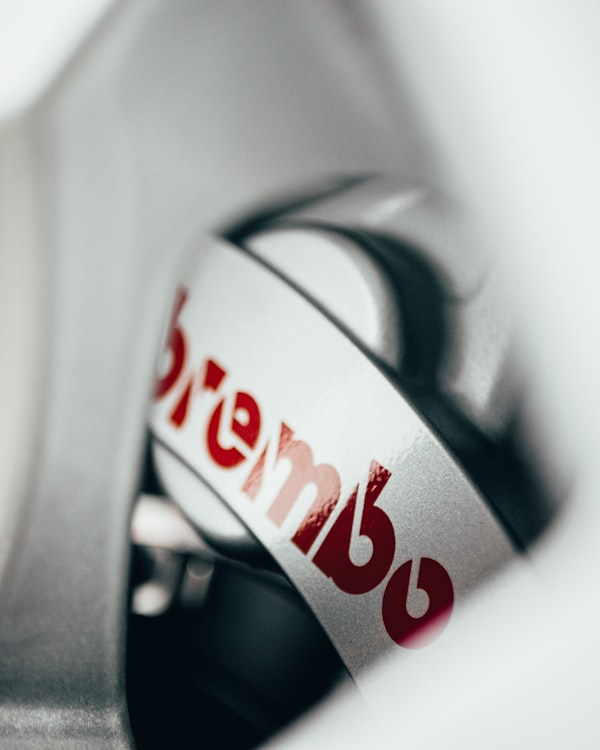What is an OEM-style shifter?
On most manual transmission BMWs, the shifter linkage consists of a sub-assembly that includes it's own "carrier", selector rod, and shift lever. In addition, there are some bushings and shims involved to keep things tight. The pivot "cup" and shims are made of hard plastics, but the carrier bushings are soft rubber, and all of the components do wear out and get sloppy over time.
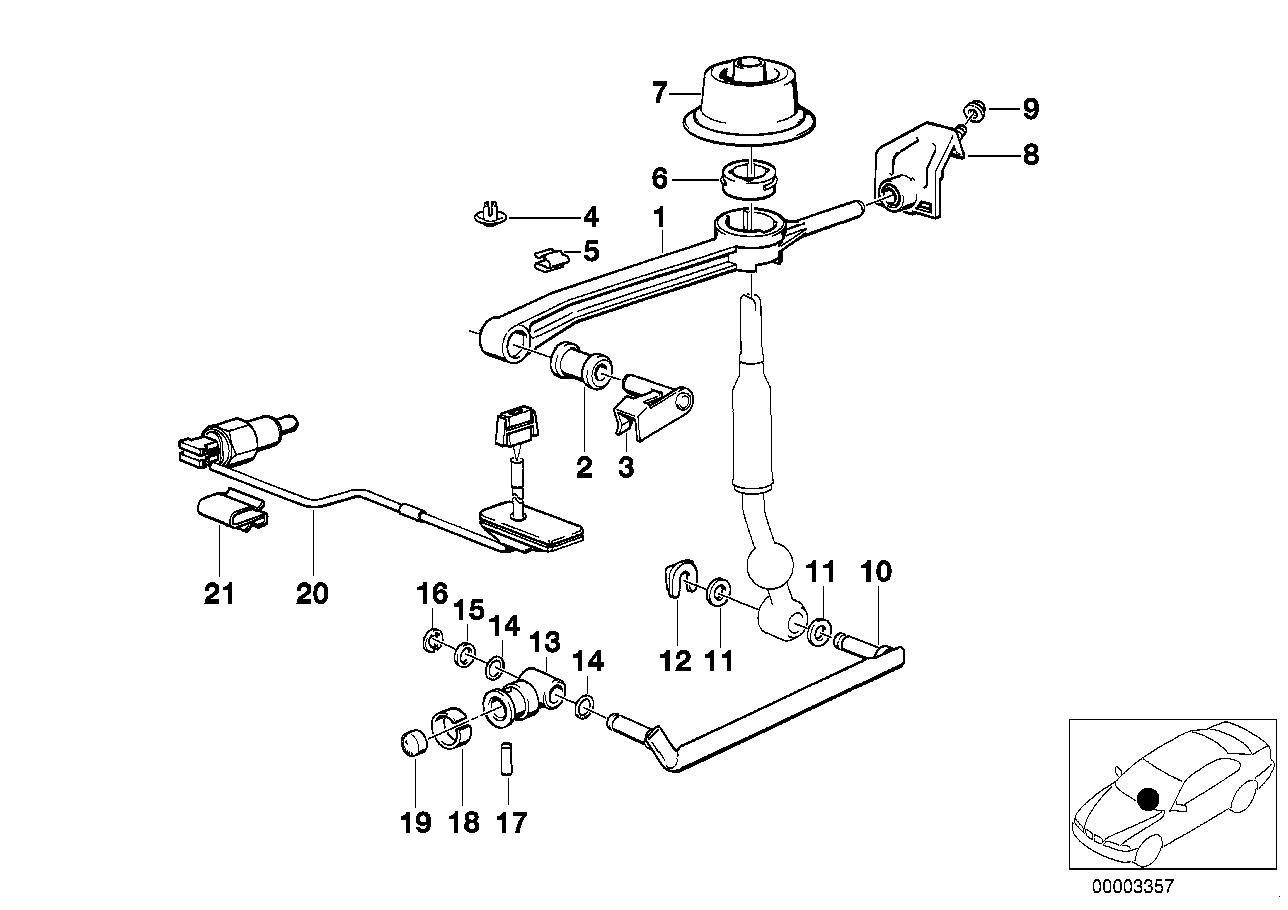
The diagram above depicts a late model E30 shifter assembly. Many subsequent generations are very similar to this design.
Part #1 is the carrier. The front of the carrier attaches to the rear of the transmission via parts #2 and #3, and the rear of the carrier attaches to the transmission tunnel via part #8. Those front and rear attachments utilize soft rubber bushings.
The shift lever (pictured next to part #11, but not numbered in this diagram) pivots on a plastic bushing, part #6 in the diagram. It interfaces with the transmission via the selector rod (#10) and the rod joint (#13).
OEM-style Shifters:
| Pros | Cons |
|---|---|
| + Long-lasting | - Imprecise shifts |
| + Forgiving | - Short lever (far from wheel) |
| + Inexpensive to rebuild | - Long shift throws |
What is a chassis-mount shifter?
Chassis-mount (sometimes called body-mount) shifters do away with the entire OEM carrier assembly, instead opting to mount the shifter assembly directly on the transmission tunnel (thus the name chassis- or body-mount). This is both good and bad- GOOD in that it provides a very solid platform for a precise, short throw shifter, BAD in that the shifter assembly no longer moves with the rest of the drivetrain (which can cause mis-shifts, more on that later).
Depending on the chassis-mount shifter design, there might be less moving parts and less complexity, but some designs opt for much more complication in order to add features such as gear-lockouts, over-throw limiting, and the ability to fine tune the shift throw to your liking.
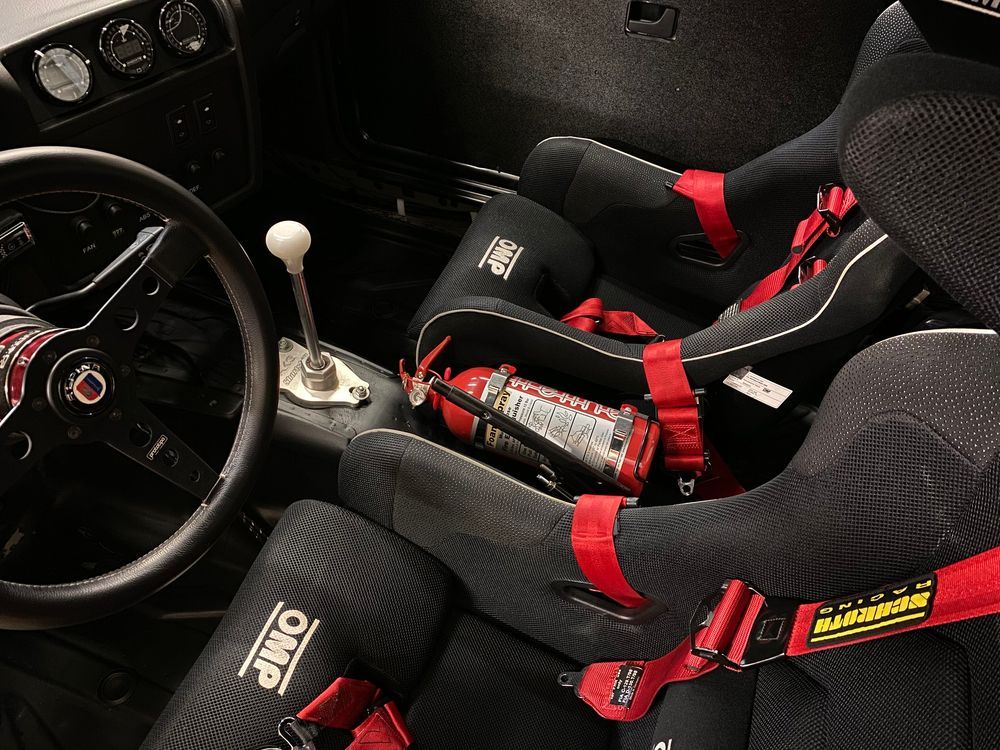
In many cases, the plastic parts associated with an OEM-style shifter are replaced with things like spherical and needle bearings, providing a more direct feel and longer lifespan, while at the expensive of increased NVH (noise, vibration, harshness).
Lastly, the "throw" of most chassis-mount shifters is ultra-short. That means that the shift lever only has to move a small amount in order to engage a gear. This typically increases the effort needed to select a gear, sometimes to an extreme degree.
Chassis-Mount Shifters:
| Pros | Cons |
|---|---|
| + Short, precise shifts | - Higher shift effort |
| + Tall lever (close to wheel) | - More noise, vibration, harshness |
| + Less slop than OEM | - Potential for missed shifts |
| + They look cool | - Requires stiff driveline bushings |
Are there any options in between?
Yes! One of the most popular upgrades for manual transmission BMWs are so called "short shift kits." These usually consist of new bushings, shims, and most importantly, a redesigned shift lever that decreases the throw of your shifts. The shift knob may sit lower or higher than the original shift lever did, but usually not by a large margin.
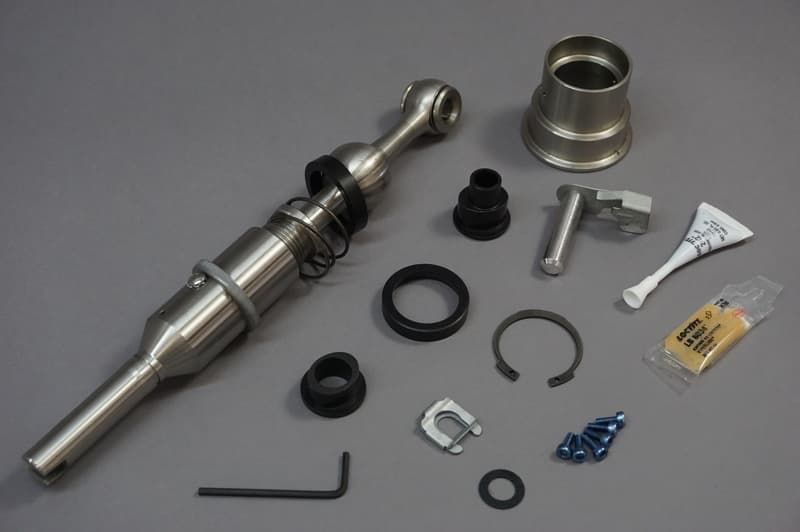
Short Shift Kits:
| Pros | Cons |
|---|---|
| + Shorter shifts | - Short lever (far from wheel) |
| + Carrier moves w/ driveline | - Usually not as precise as chassis-mount |
| + Price (can be done cheap) | - Price (some kits are expensive) |
How are shorter shifts achieved?
The main determining factor of how any shift lever functions is based on the distance from the fulcrum (the ball or pivot point of the lever) to where it attaches to the selector rod.
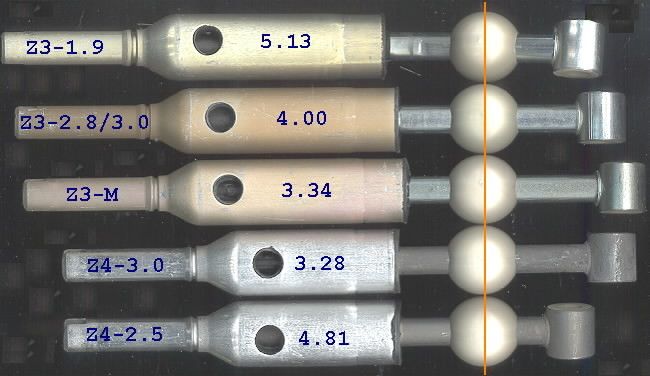
Using the image of various OEM BMW shift levers above, we can see that the lengths vary greatly. On the left side of the orange line is the interior cabin portion of the shift lever – your shift knob attaches to the top (far left of the image).
On the right side of the orange line is the portion of the shift lever that attaches to the selector rod, and then onwards to the transmission. The distance from the pivot ball to the selector rod is what determines the length of the throw, and thus, the feel of the shifter, including how "notchy" it feels (shorter throws usually feel more notchy).
The longer the lever is after the fulcrum, the shorter shift will be.
For instance, the Z3-M lever (middle) will both have a shorter throw as well as a taller shift knob location when in comparison to the Z4-2.5 lever (bottom). The throws are shorter on the Z3-M because the portion of the lever below the fulcrum is longer. The shift knob will sit higher on the Z3-M because the portion of the lever above the fulcrum is also longer (taller).
Now that we've gone over the key differences in the types of shifters on the market, we are going to focus solely on chassis-mount shifters going forward. To see why I personally prefer chassis-mount shifters, check out this article.
Requirements for Chassis-Mount Shifters
Since chassis-mount shifters remove the OEM-style shift carrier assembly that is attached to the transmission, the shifter is no longer able to "move" with the driveline. You may not think that your driveline moves around very much, but just watch a cockpit video from a BMW track car and watch how much the shifter moves around during cornering!
When the shift carrier is allowed to move along with the driveline, it helps ensure that you can still engage a gear easily even when the driveline has pivoted several degrees while loaded up in a high g-force situation.
This means that one of the key components you need in order to run a chassis-mount shifter is stiff driveline bushings/mounts.
Namely, you need the engine and transmission mounts to be stiff, as they are the components that are moving in relation to the chassis during cornering.
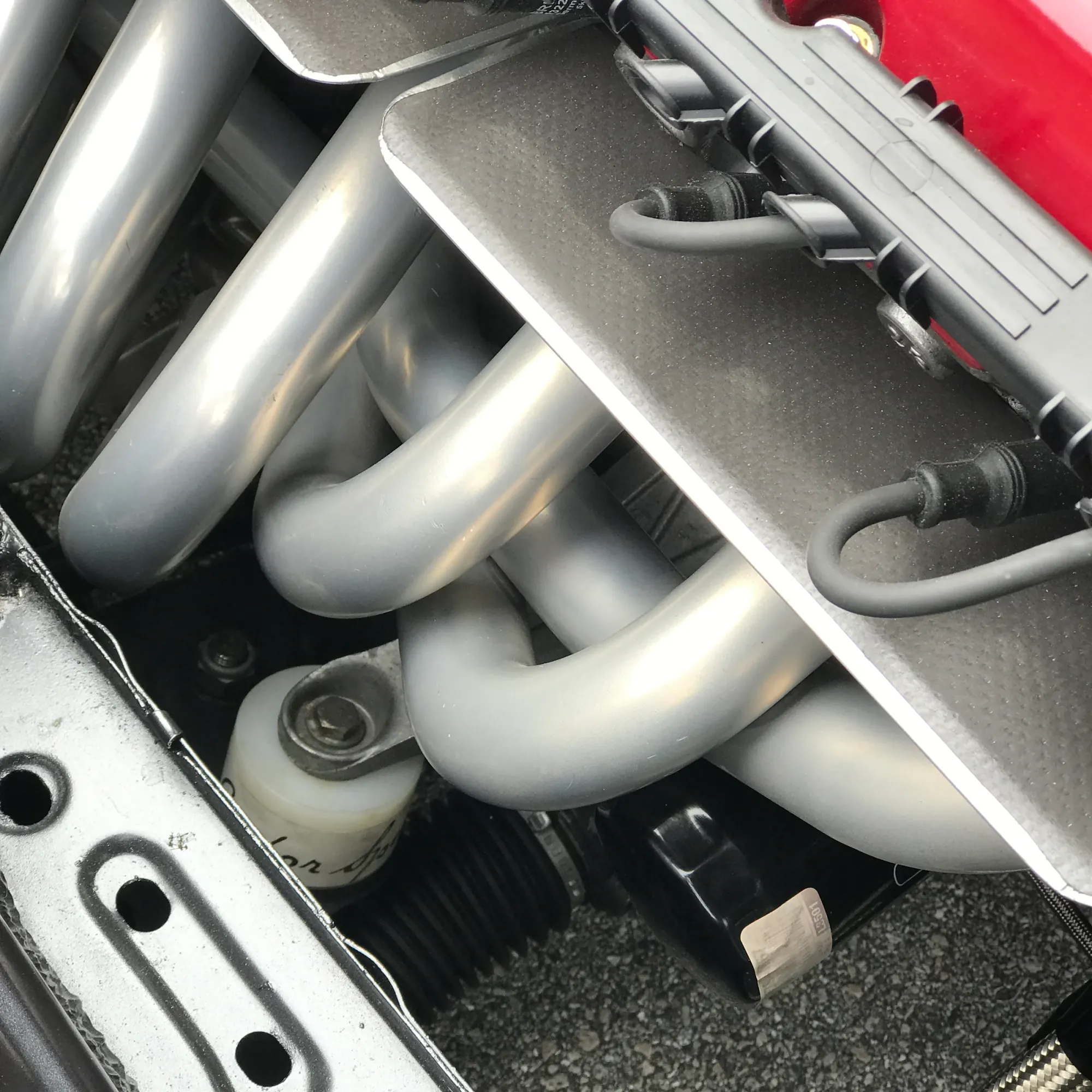
Now, popular forum-lore requires that you must always match the material of the engine mounts to the transmission mounts. I personally don't ascribe to that belief entirely; I think you can get away with a little imbalance between the two items, within reason. You wouldn't want to run aluminum engine mounts with OEM rubber transmission mounts, for instance.
In my testing, I have found that my personal preference is for a transmission mount that is one or two grades softer than the engine mount. That is mainly because almost all of the NVH that you "feel" from stiff driveline mounts correlates directly to the transmission mounts; not the engine mounts, diff bushing, or anything else along the way.
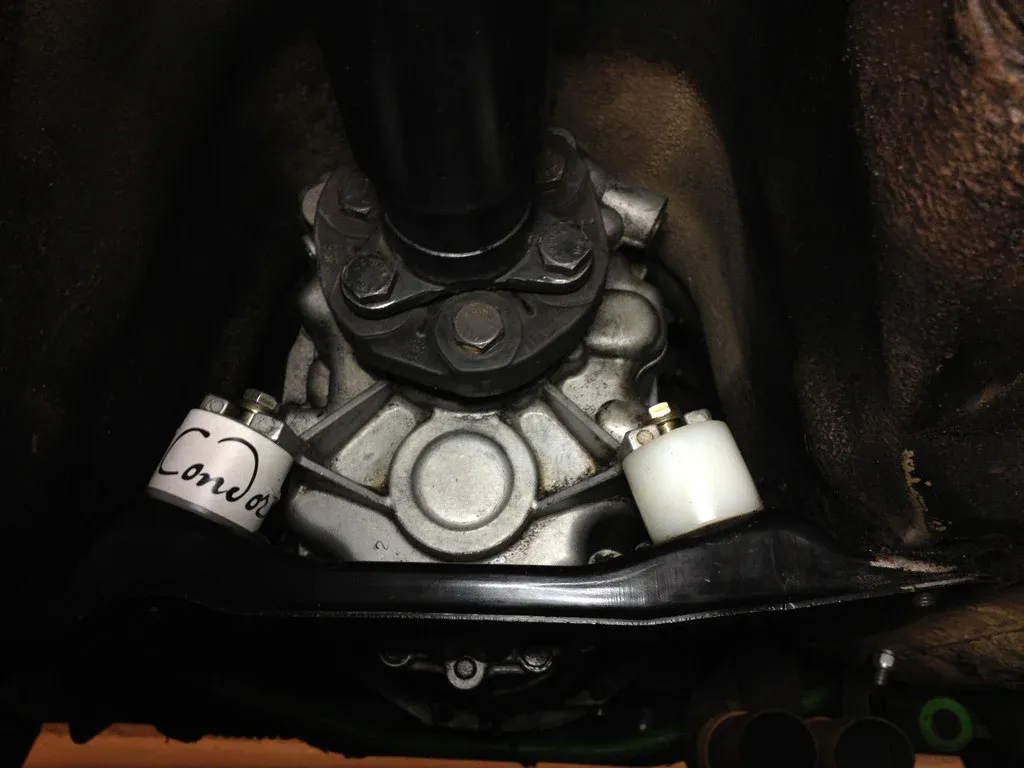
My car has an 8lb aluminum flywheel and an inexpensive 6-puck ceramic clutch, both of which contribute to added NVH. I didn't like the feel of matching engine and transmission mounts, so I went down a step on the shore scale with my transmission mounts.
I personally run UHMW (similar to Delrin) engine mounts, and "95A" shore rating polyurethane transmission mounts. The 95A poly allows just enough absorption to keep the in-cabin vibrations down, while maintaining the stiffness needed to prevent the transmission from moving all over the place in corners.
RISING EDGE PRO TIP: Start out with the same grade of engine and transmission mounts, and work your way down on the stiffness of the transmission mounts only if you need to.
Optional Items
So-called "DSSR" double-shear selector rods are a popular upgrade for any BMW manual transmission vehicle. I think that their importance is overblown, but I would still recommend running one. If you have an OEM selector rod in decent shape and shimmed properly, the upgrade to a DSSR won't make as much difference in the slop of the shifter as "they" would want you to believe, but there is no denying that a billet DSSR is stronger than the OEM selector rod.
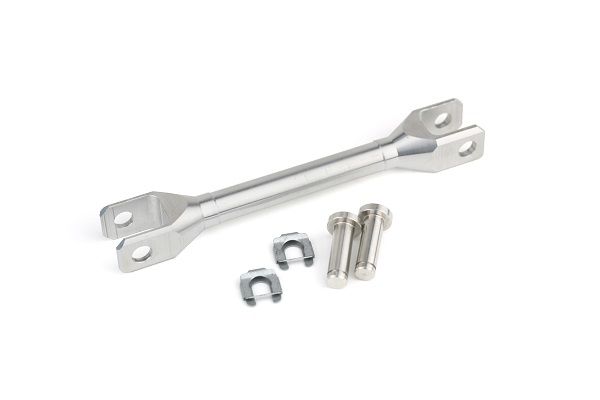
Some chassis-mount shifters allow you to change the shift knob to your liking, using either screw in knobs or even snap-in OEM-style knobs. Others will not allow for knob changes or customizations at all.
While you're there, you'll need to figure out a shift lever boot, if your shifter doesn't have a solution for that. I've generally been able to re-use an OEM boot if one is not included, usually by cutting and trimming the boot as needed.
In Summary
Required: stiff engine and transmission mounts of your choice
Optional: DSSR, shift knob of your choice, shift lever boot/seal
A note about self-centering
Many chassis-mount shifters tout a feature called "self-centering." This is typically in the form of a spring that will snap the shifter back to a neutral or vertical position all on it's own.
Some will say this feature helps improve feedback and reduces the chance of a "money shift" (throwing 1st instead of 3rd, or 2nd instead of 4th), but I think this feature is mostly a gimmick.
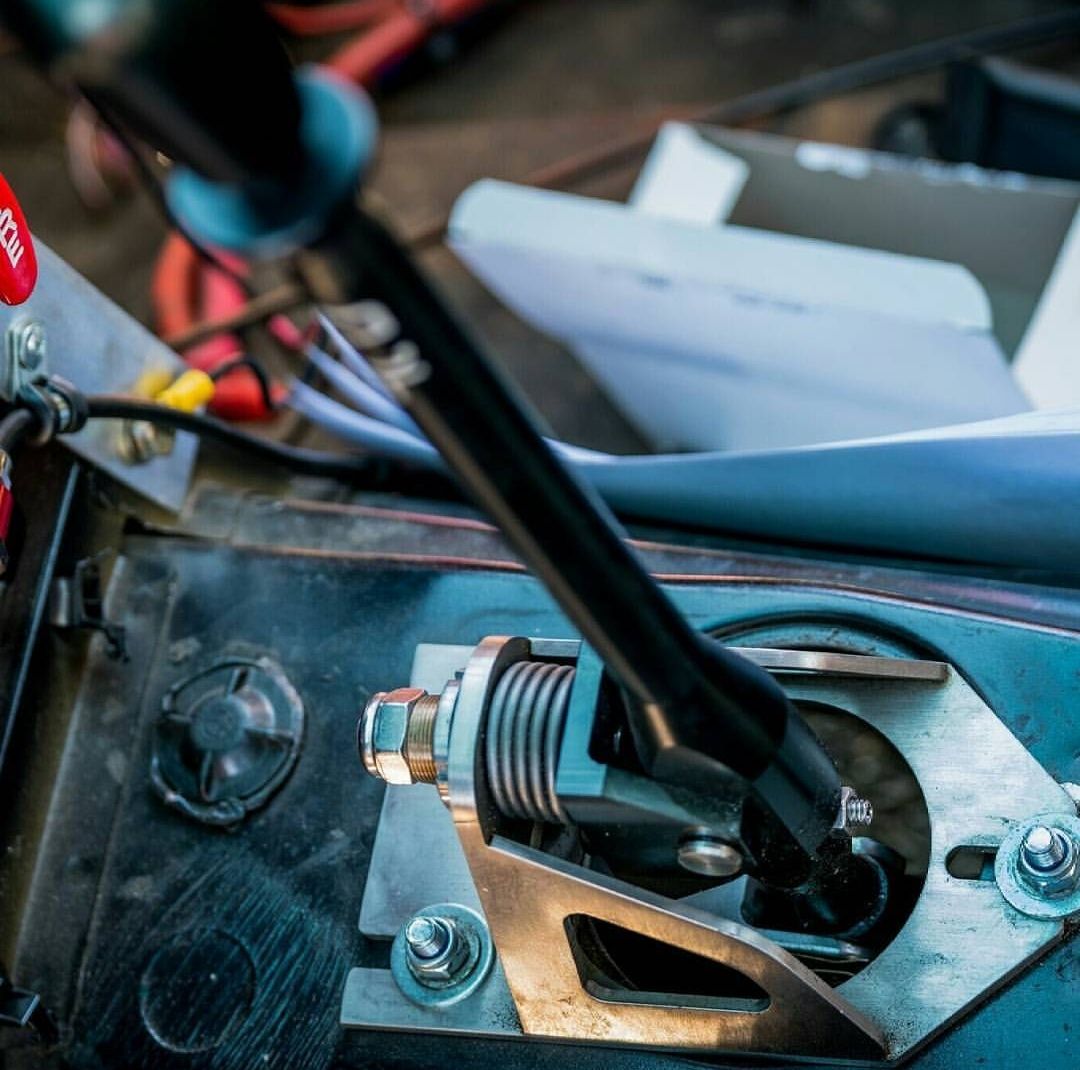
The detent pins of your transmission will naturally center the shifter on their own. There are some instances, especially with ZF320 transmissions (from late model E36s), where the detents will be so worn out that they don't reliably center the shifter any longer.
The proper fix for that is to service the detent pins. The parts are inexpensive, but it is indeed a pretty tedious job. Worn detent pins shouldn't be masked by a self-centering shifter.
The Best Chassis-Mount Shifters for your BMW
Please note that this is not a "ranked" list (it is alphabetical), and it's not exhaustive either. These are the shifters that I have either tested personally, or come highly recommended from a wide range of racers. RISING EDGE has no financial interest in any of these companies, and these are not affiliate links. All prices are as of January 2023.
Without further ado, let's get to the good stuff!

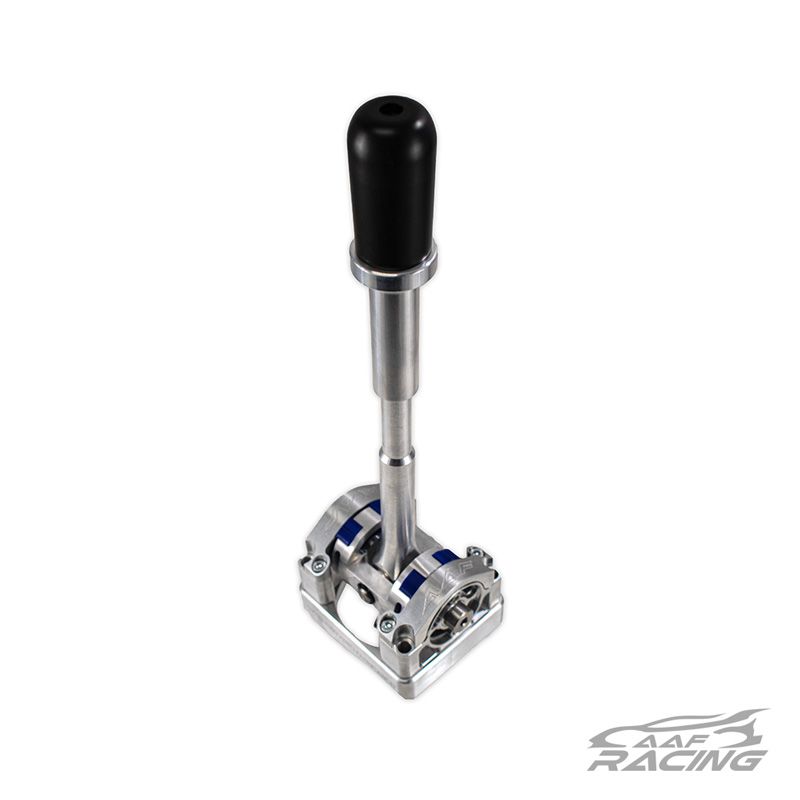
AAF BMW Race Shifter
Available from: Advanced Auto Fab
Price: $1,245 USD
Starting off the list with a bang, the AAF shifter is likely the most complex and expensive shifter on the market, south of going air-shifted sequential. With a ton of adjustments and customizations included, you will want for nothing with this shifter. Key features include:
- Adjustable fulcrum (throw ratio), knob height, and adjustable DSSR included
- Selectable spring pressure for the self-centering tension spring
- Bomb-proof billet aluminum construction
- Looks like a nuclear reactor
AAF BMW Race Shifter Summary:
| Pros | Cons |
|---|---|
| + Every adjustment imaginable | - Astronomical price |
| + No-holds-barred build quality | |
| + Comes with all options |
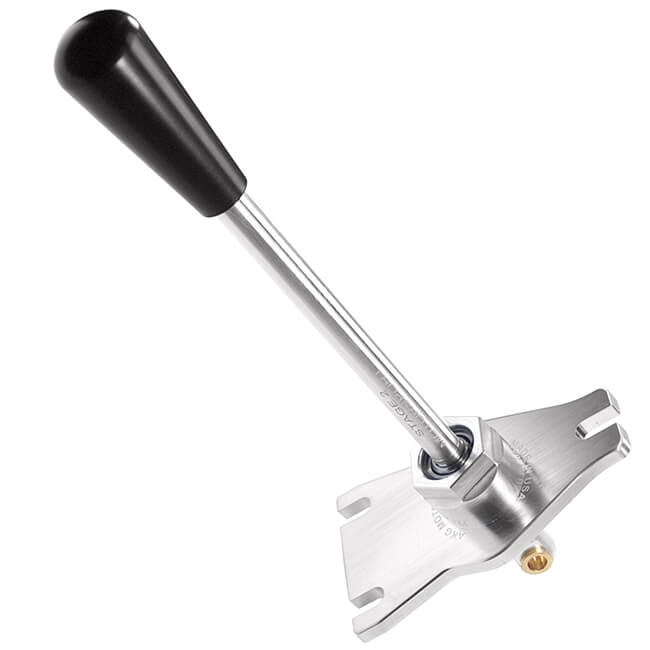
AKG Stage II Racing Shifter
Available from: AKG Motorsport
Price: $375 USD
AKG's shifter is a tried and true option based on the original BMW "DTM" design of the mid-80s. It has no frills or extra features, it just does what it needs to do, really well. Quality materials, beefy construction, made in the USA: what more can you ask for? Key features include:
- Two shift knob options
- Made in USA with high quality aluminum
- Strong spherical bushing as pivot point
- Tried and true design
- Can be used with modified OEM rubber seal
AKG Stage II Racing Shifter Summary:
| Pros | Cons |
|---|---|
| + Tried and true design | - No extra features |
| + Stout construction | - Hardware not included |
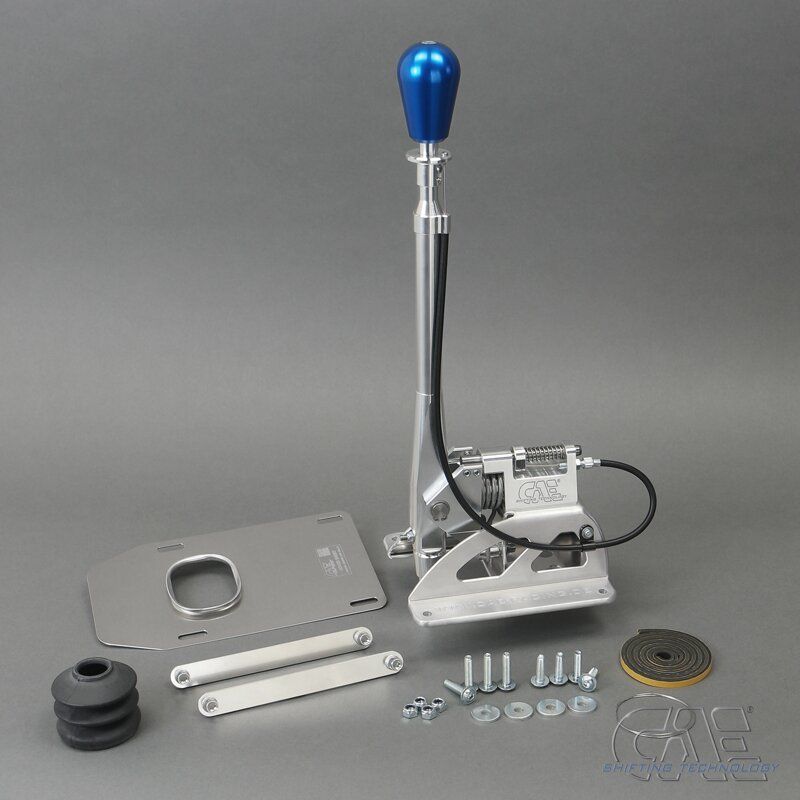
CAE Ultra Shifter
Available from: CAE
Price: 939 Euro ++
This beast is jam packed with features, and the second most expensive shifter on the list. The owners and people that have driven them swear by them. Justifying their purchase? Maybe. It is undeniably one of the most stout shifters out there, though. In fact, many of it's design features were copied and available on other shifters (cough Coolerworx / IRP cough). Key features include:
- Comes with everything you need, including rubber seal, hardware, etc.
- Bomb-proof construction
- Gear lockout and overthrow set-screws
- Customizable with lots of color options
CAE Ultra Shifter Summary:
| Pros | Cons |
|---|---|
| + Design sets the bar | - Price is out there |
| + Gear lockout + overthrow stops |
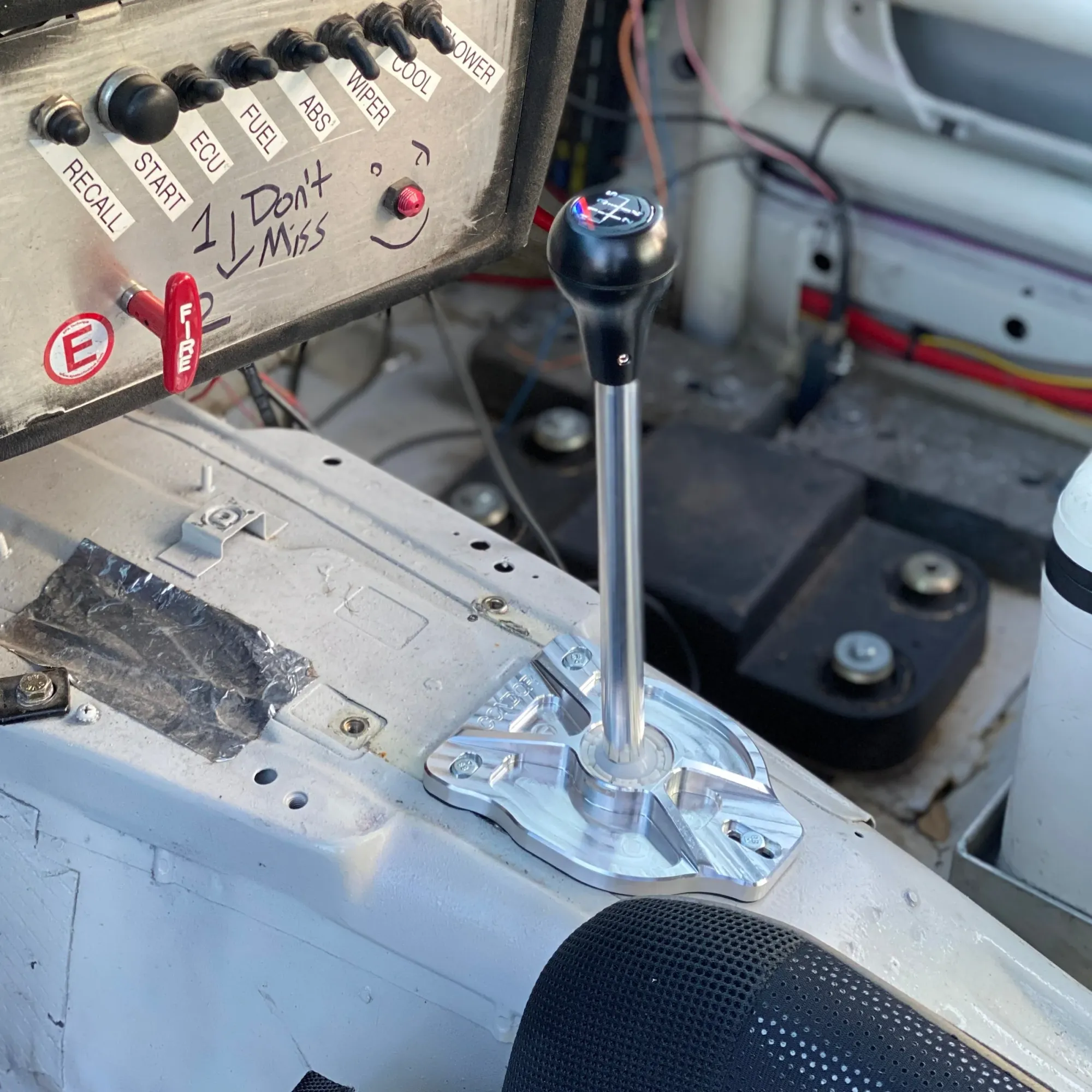
Condor Speed Shop Race Shifter
Available from: Condor Speed Shop
Price: $295-325 USD
Condor's recent entry into the chassis-mount shifter market should be given serious consideration. It has a great combination of features, quality, and an affordable price point. You're even able to choose your knob style and pattern insert for the knob. Key features include:
- Designed and Made in USA using high quality aluminum and Delrin
- Adjustable fulcrum allows you to adjust the throw
- The mounting bolts are captured, making installation easier
- Includes a custom rubber boot to seal the transmission tunnel
- You can use just about any shift knob on it
Condor Speed Shop Race Shifter Summary:
| Pros | Cons |
|---|---|
| + Represents a great value | - No gear lockout or over-throw adjustment |
| + Customizable (fulcrum height + knobs) | |
| + Beautiful machining |
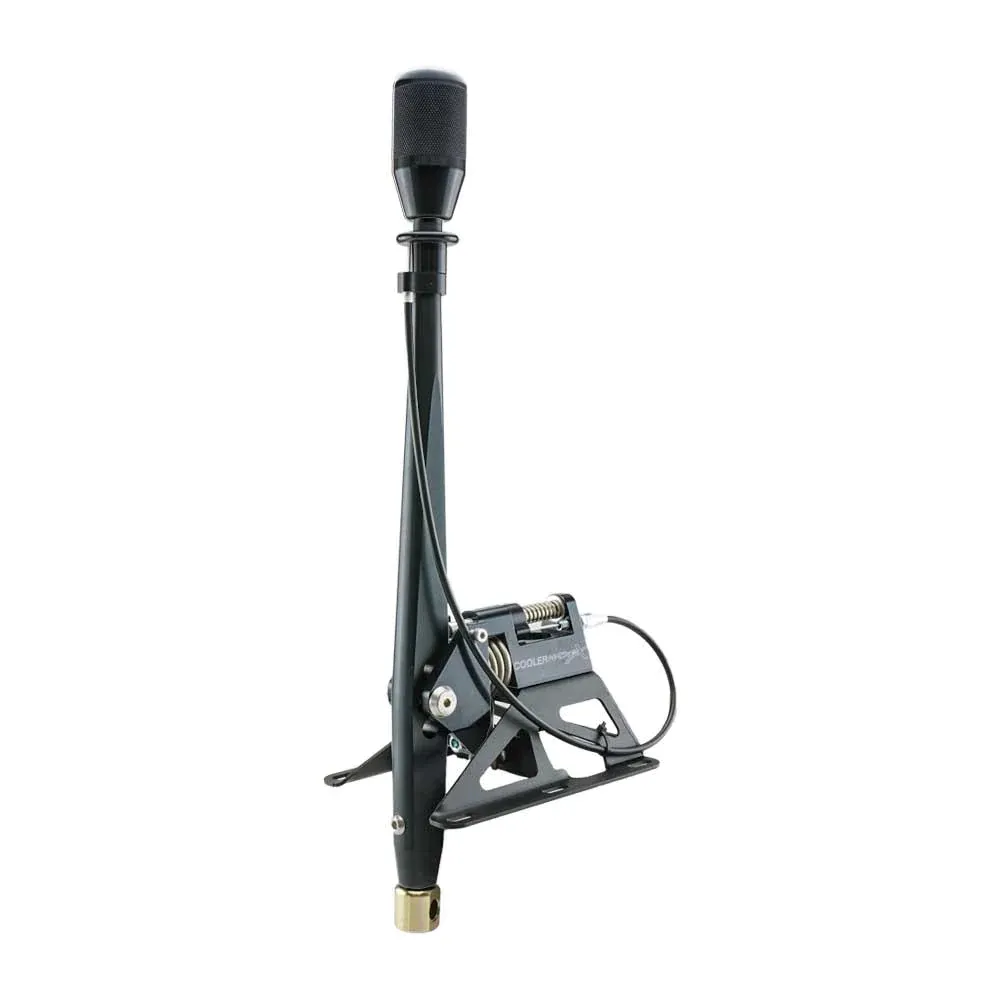
Coolerworx Short Shifter
Available from: Coolerworx
Price: $410-594 USD
Calling it like it is: this is a cheaper copy of the CAE Ultra Shifter (and so is the IRP v3). It's priced between the CAE and the IRP, and it has a much stronger mounting base than the IRP, so it may be worth the extra money. Otherwise, most of what I said about the CAE applies to this one as well, but I have not seen it in person to see where they skimped to cut the price of the CAE by more than 50%. Key features include:
- Gear lockout and overthrow set-screws
- Large, strong mounting base design
- Bearings and pivots everywhere -- it's smooth
- Can be used with OEM rubber seal
Coolerworx Short Shifter Summary:
| Pros | Cons |
|---|---|
| + Impressive feature set | - Almost direct copy of CAE |
| + Strong mounting base | - Not many options available |
| + Represents good value |
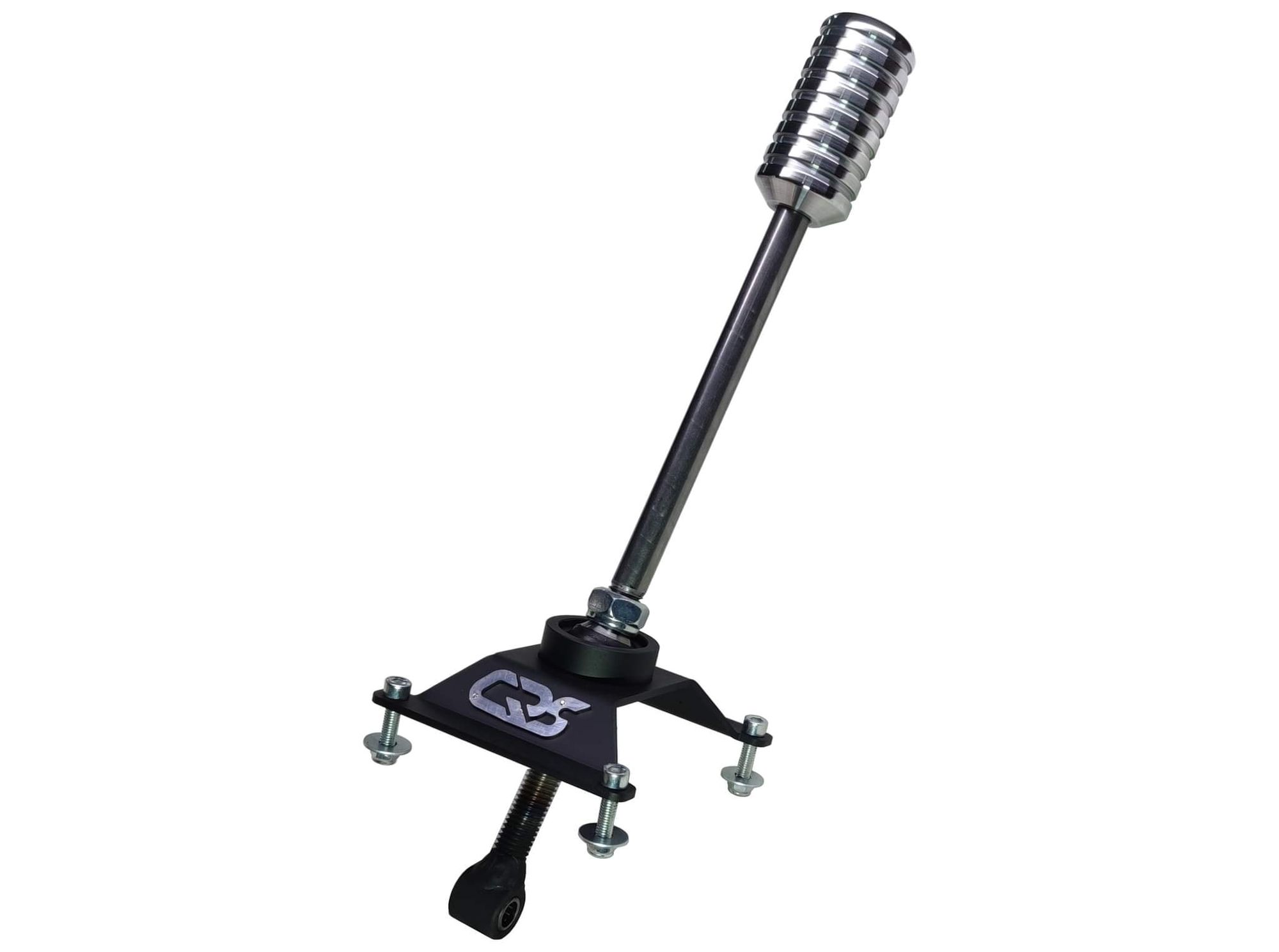
CRS Short Shifter
Available from: Rokas Stasionis (no web site)
Price: $75 USD
This is the least expensive chassis-mount shifter that I've come across, and surprisingly, it doesn't suck. I actually bought one for my 2020 Covid-project E36 M3. It's not very pretty, but it gets the job done in convincing fashion. It uses a spherical bearing with a threaded shaft and jam nuts on either side, which allows you to adjust the height and throw to your liking. Key features include:
- Mostly steel construction
- You can fine tune the height and fulcrum
- Comes with hardware
- Can be used with OEM rubber seal
CRS Short Shifter Summary:
| Pros | Cons |
|---|---|
| + Superb price | - Not the prettiest thing |
| + Steel used to save cost, but keep strength | - Small hardware used |
| + Needle bearings used on selector pivot |
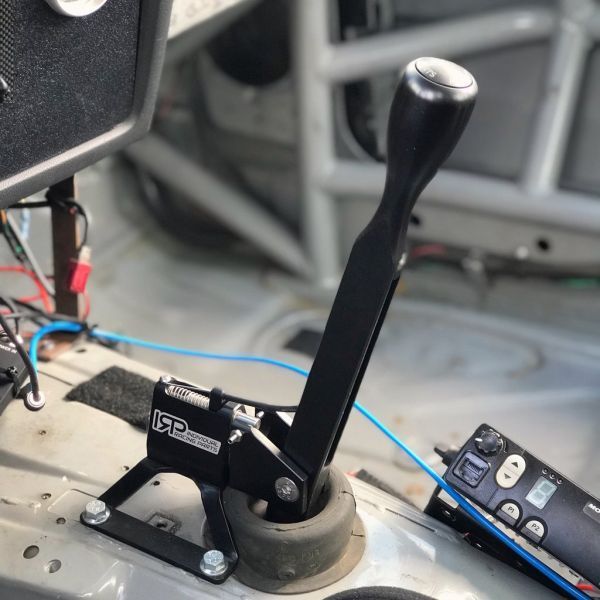
IRP v3 Short Shifter
Available from: IRP
Price: 320 Euro
You may recognize some of the features of this shifter from CAE's design, but this shifter is 1/3 the cost. It's not quite as nice as the CAE (or the Coolerworx), but it's still built to a high standard, and should serve most people perfectly well. One area of potential improvement for this one is the mounting base: it would benefit from being a little bit thicker and sturdier. Still, I haven't had any major issues with mine in 4 years, although I recommend assembling everything with blue loctite. Key features include:
- Adjustable lockouts and overthrow set-screws
- Bearings and pivots everywhere -- it's smooth
- Raised pivot point keeps the selector shaft in-line
- Ergonomic integrated shift knob looks sleek
- Can be used with OEM rubber seal
IRP v3 Short Shifter Summary:
| Pros | Cons |
|---|---|
| + Impressive feature set | - Mounting base could be stronger |
| + Represents good value | - Integrated shift knob (no options) |
| + Color options available |
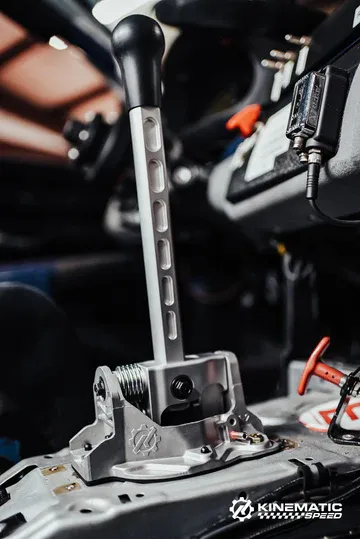
Kinematic Speed The Race Shifter
Available from: Kinematic Speed
Price: $699-783
One of the most innovative designs on the market, North Carolina-based Kinematic Speed's entry into the chassis-mount shifter is a sight to behold. It features a large, cast-aluminum base, adjustments and bearings galore, and two selector rod joints so you can select your shift throw preference. Key features include:
- Cast aluminum base integrates gear lockout and overthrow adjustments
- Self-centering design with radial bearing pivots
- The hardware is captured for easier one-man installation
- Comes with everything you need including a rubber seal and hardware
- Made in USA
Kinematic Speed The Race Shifter Summary:
| Pros | Cons |
|---|---|
| + Innovative design | - One of the more expensive options |
| + Bomb-proof construction |
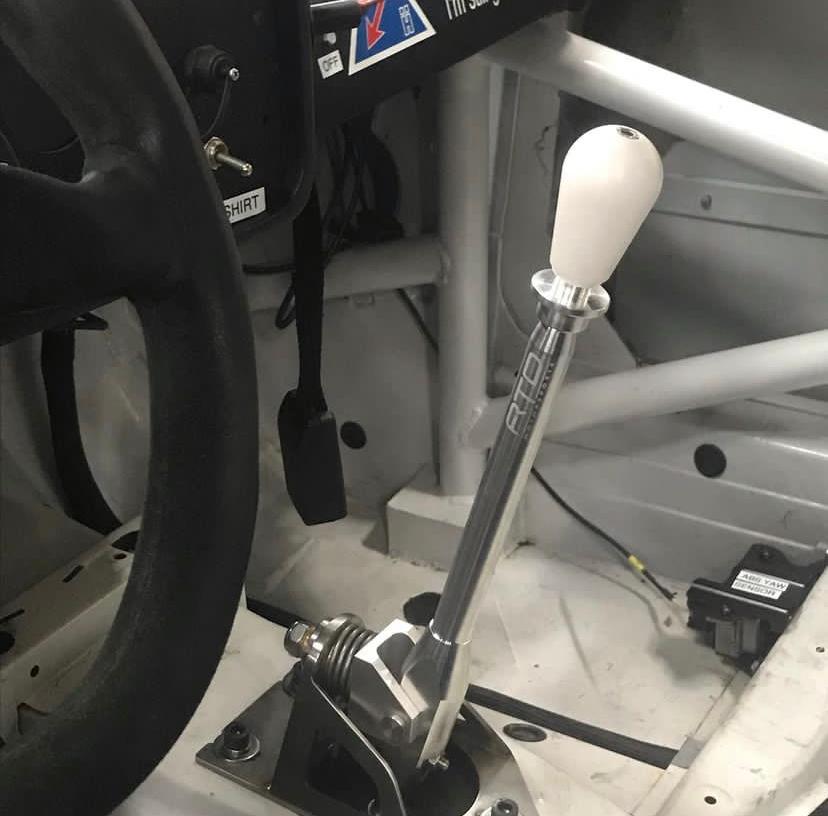
RTD BMW-Aluminum Short Shifter
Available from: RTD Motorsports
Price: $509-829 USD
RTD's offering has a lot of great features and an attractive, middle-of-the-road price point. They have a few options available, including one with reverse lockout. All of their options have a self-centering spring. I'd opt against it if they offered one without, but it's a key part of their design. This shifter operates very smoothly and has a nice, strong mounting base. Key features include:
- Innovative pivot design that integrates a self-centering spring
- Strong billet aluminum materials used throughout
- The mounting base is very strong
- Lots of color options available
RTD BMW-Aluminum Short Shifter Summary:
| Pros | Cons |
|---|---|
| + Attractive design | - Not available w/o self-centering |
| + Bronze bushings will last forever |

That was a lot to cover. Hopefully you enjoyed and learned from this buyer's guide If you have any feedback or questions, as always we encourage you to contact us. You can also reply to this email if you are subscribed and seeing it in your inbox.
If you enjoyed this guide, please subscribe to RISING EDGE; it's free and fun!


